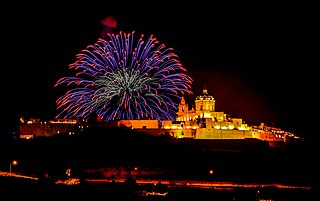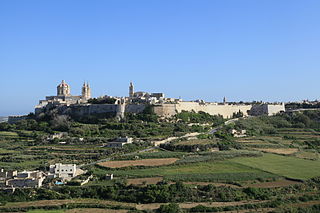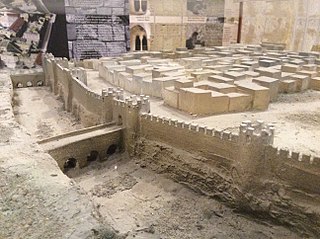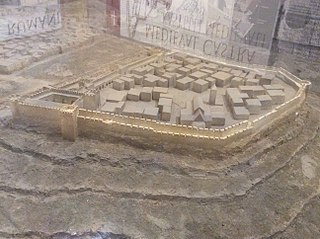
Malta has been inhabited since 5900 BC. The first inhabitants were farmers; their agricultural methods degraded the soil until the islands became uninhabitable. The islands were repopulated around 3850 BC by a civilization that at its peak built the Megalithic Temples, which today are among the oldest surviving buildings in the world. Their civilization collapsed in around 2350 BC; the islands were repopulated by Bronze Age warriors soon afterwards.

Year 1091 (MXCI) was a common year starting on Wednesday of the Julian calendar.

Roger I, nicknamed “Roger Bosso” and “Grand Count Roger”, was a Norman nobleman who became the first Grand Count of Sicily from 1071 to 1101.

The culture of Malta has been influenced by various societies that have come into contact with the Maltese Islands throughout the centuries, including neighbouring Mediterranean cultures, and the cultures of the nations that ruled Malta for long periods of time prior to its independence in 1964.

Mdina, also known by its Italian-language titles Città Vecchia and Città Notabile, is a fortified city in the Northern Region of Malta which served as the island's capital from antiquity to the medieval period. The city is still confined within its walls, and has a population of 250, but it is contiguous with the town of Rabat, which takes its name from the Arabic word for suburb, and has a population of over 11,000.

The Maltese people are an ethnic group native to Malta who speak Maltese, a Semitic language and share a common culture and Maltese history. Malta, an island country in the Mediterranean Sea, is an archipelago that also includes an island of the same name together with the islands of Gozo and Comino ; people of Gozo, Gozitans are considered a subgroup of the Maltese.

The Emirate of Sicily or Fatimid Sicily was an Islamic kingdom that ruled the Muslim territories on the island of Sicily between 831 and 1091. Its capital was Palermo, which, during this period, became a major cultural and political center of the Muslim world.
Siculo-Arabic or Sicilian Arabic is the term used for varieties of Arabic that were spoken in the Emirate of Sicily from the 9th century, persisting under the subsequent Norman rule until the 13th century. It was derived from Arabic following the Abbasid conquest of Sicily in the 9th century and gradually marginalized following the Norman conquest in the 11th century.

Islam in Malṭa has had a historically profound influence upon the country—especially its language and agriculture—as a consequence of several centuries of control and presence on the islands. Today, the main Muslim organizations represented in Malta are the Libyan World Islamic Call Society.
The County of Malta was a feudal lordship of the Kingdom of Sicily, relating to the islands of Malta and Gozo. Malta was essentially a fief within the kingdom, with the title given by Tancred of Sicily the Norman king of Sicily to Margaritus of Brindisi in 1192 who earned acclaim as the Grand Admiral of Sicily. Afterwards the fiefdom was passed from nobleman to nobleman remaining as a family possession in a few instances. It was used mainly as a bargaining tool in Sicilian politics leading to a rather turbulent history. The fiefdom was elevated to a Marquisate in 1392 and either title was no longer used after 1429.

The Norman conquest of southern Italy lasted from 999 to 1194, involving many battles and independent conquerors.

The Metropolitan Cathedral of Saint Paul, commonly known as St Paul's Cathedral or the Mdina Cathedral, is a Catholic cathedral in Mdina, Malta, dedicated to St. Paul the Apostle. The cathedral was founded in the 12th century, and according to tradition it stands on the site of where Roman governor Publius met St. Paul following his shipwreck on Malta. The original cathedral was severely damaged in the 1693 Sicily earthquake, so it was dismantled and rebuilt in the Baroque style to a design of the Maltese architect Lorenzo Gafà between 1696 and 1705. The cathedral is regarded as Gafà's masterpiece.

The Invasion of Gozo took place in July 1551, and was accomplished by the Ottoman Empire against the island of Gozo, following an unsuccessful attempt to conquer nearby Malta on 18 July 1551. It was followed by a victorious campaign with the siege of Tripoli.

The fortifications of Mdina are a series of defensive walls which surround the former capital city of Mdina, Malta. The city was founded as Maleth by the Phoenicians in around the 8th century BC, and it later became part of the Roman Empire under the name Melite. The ancient city was surrounded by walls, but very few remains of these have survived.

Melite or Melita was an ancient city located on the site of present-day Mdina and Rabat, Malta. It started out as a Bronze Age settlement, which developed into a city called Maleth under the Phoenicians, and became the administrative centre of the island. The city fell to the Roman Republic in 218 BC, and it remained part of the Roman and later the Byzantine Empire until 870 AD, when it was captured and destroyed by the Aghlabids. The city was then rebuilt and renamed Medina, giving rise to the present name Mdina. It remained Malta's capital city until 1530.

The siege of Melite was the capture of the Byzantine city of Melite by an invading Aghlabid army in 870 AD. The siege was initially led by Halaf al-Hādim, a renowned engineer, but he was killed and replaced by Sawāda Ibn Muḥammad. The city withstood the siege for some weeks or months, but it ultimately fell to the invaders, and its inhabitants were massacred and the city was sacked.

The siege of Medina was an unsuccessful Byzantine attack on the Muslim city of Medina, Malta in 1053 or 1054. The Muslim inhabitants of the city and their slaves managed to repel a superior Byzantine force, which retreated with heavy losses. After the siege, the slaves who helped the Muslims against the invaders were freed, and the Byzantines never attempted to retake the island.

Malta was ruled by the Byzantine Empire, from the time of the Byzantine conquest of Sicily in 535-6 to 869-870, when the islands were occupied by Arabs. Evidence for the three centuries of Byzantine rule in Malta is very limited, and at times ambiguous. Historians theorise that Byzantine Malta was exposed to the same phenomena affecting the Central Mediterranean, namely a considerable influx of Greek settlers and Hellenic culture, administrative changes brought about by the reorganisation of Sicily along the lines of a Byzantine theme, and significant naval activity in the Mediterranean following the rise of Islam.




















